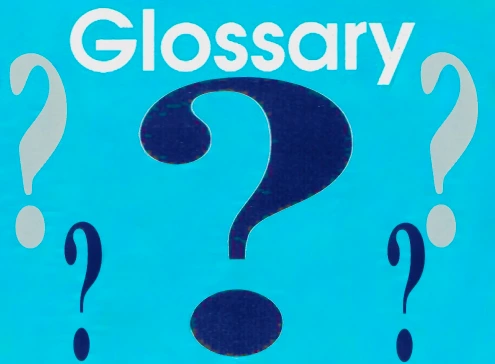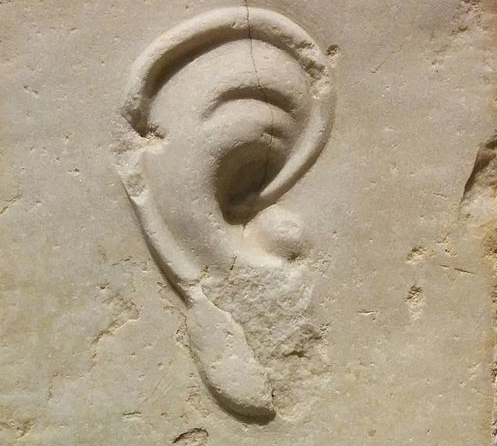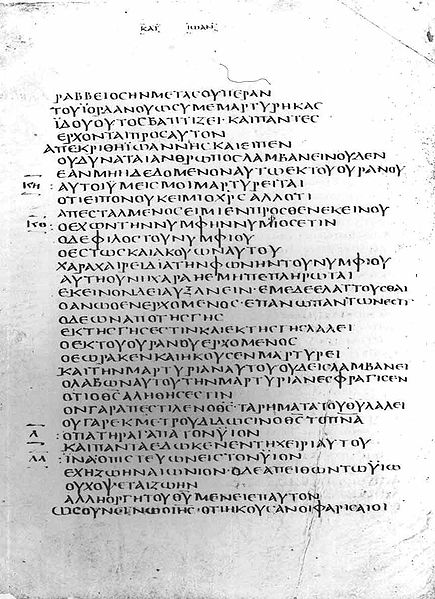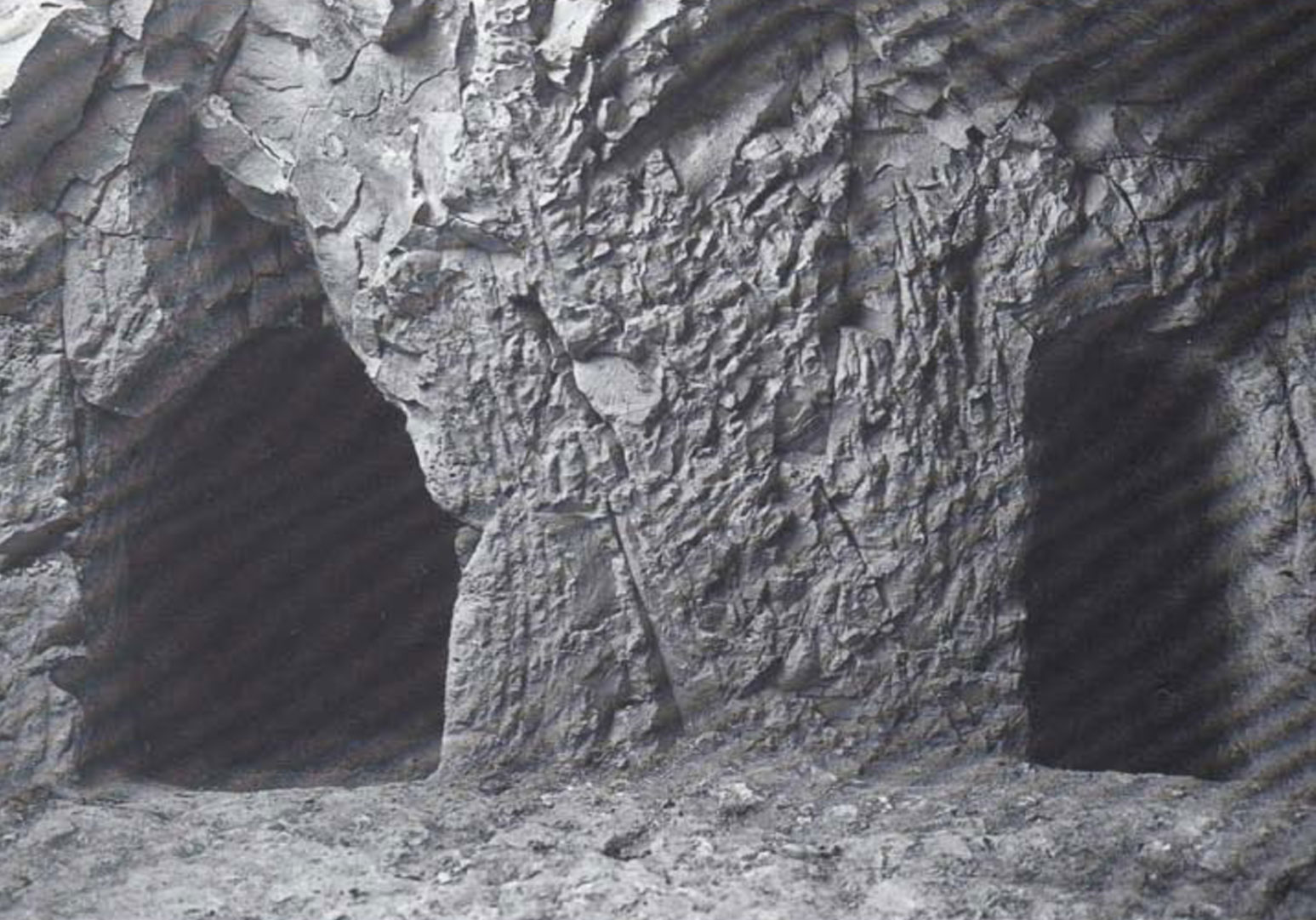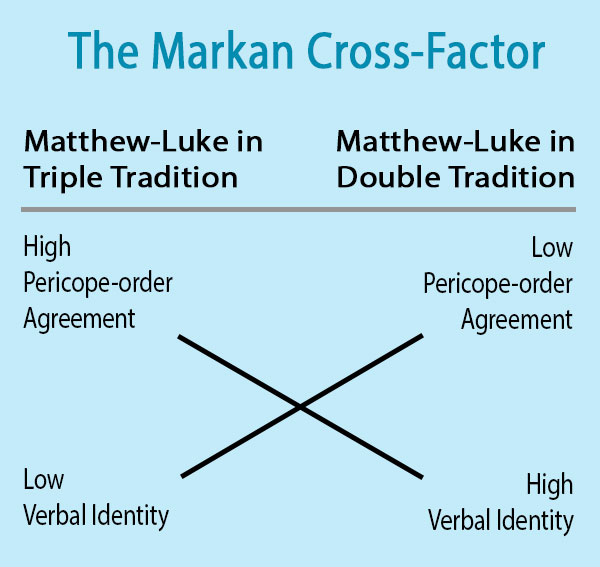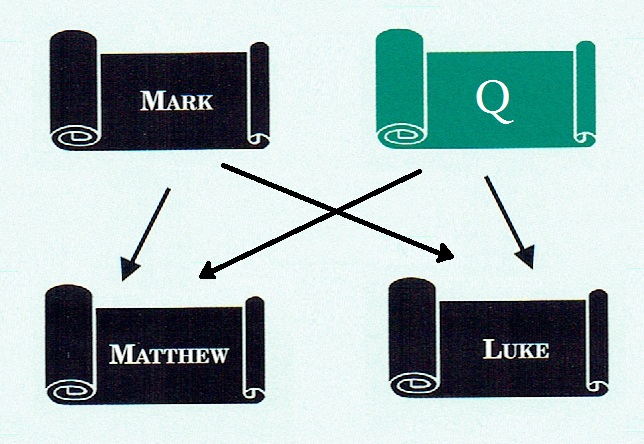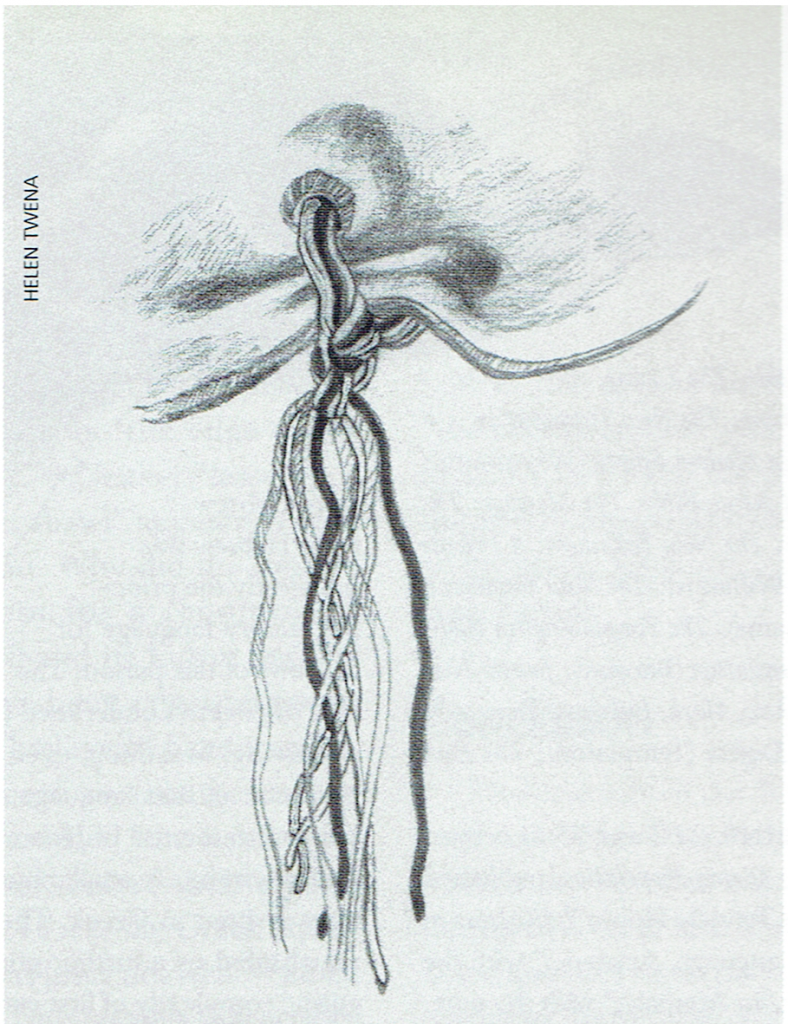Updated: 11 July 2025
|
– A – B – C – D – E – F – G – H – I – J – K – L – M – N – O – P – Q – R – S – T – U – V – W – X – Y – Z – |
Click the ![]() icon to hear pronunciation of Hebrew terms.
icon to hear pronunciation of Hebrew terms.
A
aggadah (אַגָּדָה, ’a⋅gā⋅DĀH; also haggadah [הַגָּדָה, ha⋅gā⋅DĀH]) — the ethical sayings and scriptural exposition of the sages, in contrast to their halakhic statements; the non-legal part of rabbinic literature, in contrast to halakhah.
aggadic — (ǝ⋅gäd′⋅ik) pertaining to aggadah.
am haaretz — (עַם הָאָרֶץ, ‘am hā⋅’Ā⋅retz, “a people of the land”; plural: עַמֵּי הָאָרֶץ, ‘a⋅MĒ hā⋅’Ā⋅retz) a term used in rabbinic sources to describe a member of the Jewish community who was not scrupulous with respect to tithes and ritual purity. The term was originally used in contrast to ḥaver, but eventually came to refer to anyone who did not carefully observe the halakhah of the sages.
Amidah — (עֲמִידָה, ‘a⋅mi⋅DĀH, “standing”) one of the names of the Eighteen (see below) benedictions, the central prayer of Judaism.
amoraim — (אָמוֹרָאִים, ’ā⋅mō⋅rā⋅’IM; singular: אָמוֹרָא, ’ā⋅mō⋅RĀ’, amora) the sages of the talmudic period, as distinguished from the earlier tannaim, the sages of the mishnaic period. Roughly speaking, the tannaim are the sages quoted in the Mishnah and contemporary rabbinic works, while the amoraim are the sages mentioned in the Gemara.
amoraic — (ä⋅mō⋅rä′⋅ik) pertaining to the amoraim.
Anthologizer — the author of the Anthology, one of the pre-synoptic sources according to Lindsey’s hypothesis.
Anthology — abbreviated Anth. The name Robert Lindsey gave to the longer and more Hebraic of the two pre-synoptic sources utilized by the author of Luke according to Lindsey’s synoptic hypothesis (the other source being the First Reconstruction). According to Lindsey, the authors of Mark and Matthew also utilized Anth. Lindsey believed the Anthologizier (the creator of Anth.) separated teachings from incidents and parables from teachings that once existed in “narrative-sayings complexes” in the Greek translation of an early Hebrew biography of Jesus.
Anti-Jewish — prejudice against the Jewish religion and those who practice it. Anti-Jewish sentiment is pre-Christian, but as believers from Gentile backgrounds joined the Church they sometimes brought their anti-Jewish prejudices against them.
Anti-Semitic — of or pertaining to anti-Semitism.
Anti-Semitism — prejudice against the descendants of Shem (“Semites”), the Jews in particular. Anti-Semitism is a perverse offshoot of anti-Jewish sentiment with a pseudo-scientific racial underpinning. Whereas anti-Jewish sentiment is aimed against the Jewish religion and its practitioners, anti-Semitism is aimed at the “race” or ethnicity of the Jewish people. According to this warped view even if a Jew converts to a different religion or becomes totally secular he or she is still contaminated by their Jewish ancestry. Christians have been (and often continue to be) guilty of both anti-Jewishness and anti-Semitism.
apocalypse — a literary genre in which visions reveal a heavenly perspective on earthly events and in which mysteries of the universe are disclosed. Although there is a popular misconception that apocalypses are mainly concerned with future events, the historical surveys of the past, the heavenly tours that reveal the secret workings of creation, and the political messages encoded in symbolic language, which are typical of apocalypses, demonstrate that the real focus of apocalyptic literature is on how its readers are to understand and live in the present.
apocalyptic — pertaining to an apocalypse.
Apocrypha — (ə⋅päk′⋅rə⋅fə) books included in the Septuagint and Vulgate, but excluded from the Hebrew Bible and Protestant canon. The Apocrypha contains 1 and 2 Esdras, Tobit, Judith, additions to Esther, The Wisdom of Solomon, Ecclesiasticus (= Ben Sira), Baruch, The Letter of Jeremiah, The Prayer of Azariah and The Song of the Three Young Men, Susanna, Bel and the Dragon, The Prayer of Manasseh and 1 and 2 Maccabees.
Aramaic — (ar⋅ǝ⋅mā′⋅ik) a northwest Semitic language closely related to Hebrew. The earliest Aramaic inscriptions date from the ninth-tenth centuries B.C.E. Its square script replaced the Hebrew archaic script, and by the time of Jesus was the normal script for writing in Hebrew.
Aramaism — the use of a non-Aramaic term in an unusually Aramaic sense or the use of a grammatical construction in a non-Aramaic language that resembles Aramaic usage.
B
B.C.E. — abbreviation of “Before Common Era,” corresponding to B.C. in Christian terminology. Jerusalem Perspective uses B.C.E. and C.E. in articles authored by Jewish scholars since many Jews feel unable to use B.C. (before Christ) and A.D. (anno Domini, in the year of our Lord) without compromising their beliefs.
bar — the Aramaic word בַּר (bar, “son,” “son of”). In the Second Temple period bar often was used together with the father’s name or a family nickname to distinguish males bearing the same personal name. Females with the same personal name often were distinguished by adding בְּרַת (be⋅RAT, “daughter,” “daughter of”) and the father’s name. The Hebrew equivalents of bar and be⋅RAT are בֵּן (bēn, “son”) or בֶּן (ben, “son of”) and בַּת (bat, “daughter,” “daughter of”).
baraita — (בָּרַיְתָא, bā⋅RAI⋅tā’, literally, “outside”; plural: baraitot) a tannaic saying excluded from the Mishnah of Rabbi Yehudah ha-Nasi, that is, teachings that predate 230 C.E. Baraitot were incorporated in later rabbinic works such as the Talmud.
bat kol — (בַּת קוֹל, bat qōl, literally, “daughter of a voice”) a heavenly voice that communicates the will of God.
ben — (בֵּן, bēn, “son,” or בֶּן, ben, “son of”). In the Second Temple period there were relatively few personal names, and ben often was used together with the father’s name to distinguish males bearing the same personal name. Females with the same personal name often were distinguished by adding בַּת (bat, “daughter,” “daughter of”) and the father’s name.
bet din — (בֵּית דִּין, bēt din, “house of decision”) a rabbinic court.
bet Hillel — (בֵּית הִלֵּל, bēt hi⋅LĒL, “house of Hillel”) Hillel was a Pharisaic sage of the first century who represented the liberal wing of the Pharisaic movement. Hillel’s disciples and the disciples of his disciples were referred to collectively as “the house [i.e., school] of Hillel.”
bet keneset — (בֵּית כְּנֶסֶת, bēt ke⋅NE⋅set, “house of assembly”) a synagogue.
bet midrash — (בֵּית מִדְרָשׁ, bēt mid⋅RĀSH, “house of study”) a center for study and teaching of the Torah. In the first century, the bet midrash was usually connected to a synagogue, and learning took place in the synagogue’s assembly hall or in a room adjoining it.
bet Shammai — (בֵּית שַׁמַּי, bēt sha⋅MAY, “house of Shammai”) Shammai was a sage of the first century who represented the conservative wing of the Pharisaic movement. Shammai’s disciples and the disciples of his disciples were referred to collectively as “the house [i.e., school] of Shammai.”
burial chamber — a central room of a burial cave into the sides of which may be cut loculi, or burial recesses.
C
catechesis — (κατήχησις, kat⋅Ē⋅chē⋅sis, “oral instruction”), primarily that which is given to new believers regarding the Christian faith, especially as candidates for baptism.
catechetical — pertaining to catechesis.
C.E. — abbreviation of “Common Era,” corresponding to A.D. in Christian terminology. JP uses B.C.E. and C.E. since many Jews feel uncomfortable with the use of B.C. (before Christ) and A.D. (anno Domini, in the year of our Lord).
codex — (kō′⋅deks; plural: codices [kō′⋅də⋅sēz]) a manuscript whose sheets of papyrus or parchment are fastened together in the form of a book, rather than rolled into a scroll.
Codex Bezae — late fifth-early sixth-century Greek-Latin manuscript of the Gospels and Acts.
D
darshan — (דַּרְשָׁן, dar⋅SHĀN) a Jewish preacher who is particularly skilled in aggadah and gives sermons and expositions of the scriptural text in accordance with midrashic exegesis.
Derech Eretz Zuta — later the basis for Seder Eliyahu, this work, according to Shmuel Safrai, is a repository of ancient Hasidic teaching.
Diaspora — (dī⋅as′⋅pǝ⋅rǝ) the area outside the land of Israel settled by Jews, or the Jews who settled there.
Didache — (διδαχή, di⋅da⋅CHĒ, “teaching,” “instruction”) when capitalized refers to an early Christian catechetical document with moral teachings and instructions on Christian rituals (e.g., baptism, the eucharist) and the organization of the believing community. The Didache has many points in common with the Gospel of Matthew and may have been composed by and for the same broader community and made use of some of the same sources. Incorporated into the Christian Didache is an older Jewish document which scholars refer to as the Two Ways. The Jewish Two Ways has features in common with the Derech Eretz literature.
dominical — adjective (from Latin dominus (“lord”). Originating from or pertaining to Jesus. In Gospel studies a saying that is dominical is one that was spoken by Jesus.
Double Tradition (DT) — pericopae (story units) shared only by Matthew and Luke, for instance, the Beatitudes or the Lord’s Prayer.
E
“Eighteen” — (שְׁמוֹנֶה עֶשְׂרֵה, she⋅mō⋅NEH ‘es⋅RĒH) the central prayer in Jewish life and liturgy. It is also known as עֲמִידָה (‘a⋅mi⋅DĀH, “standing”) because it is said standing; or simply תְּפִלָּה (te⋅fi⋅LĀH, “prayer”), the prayer par excellence. The prayer originally consisted of eighteen benedictions, and thus the name “Eighteen.” Its final version dates from about 90-100 C.E. when a nineteenth benediction was added. Every Jew is religiously obligated to pray the “Eighteen” daily; however, in times of emergency saying an abbreviated form of the prayer may fulfill this obligation.
eruv ḥatserot — (עֵירוּב חֲצֵירוֹת, ‘ē⋅RŪV ḥa⋅tzē⋅RŌT, “mixing or blending of courtyards”) the symbolic union of a neighborhood or settlement’s private property (private dwellings) and public domain (e.g., common courtyards, alleys and streets). The new entity is considered private property, jointly owned by the residents. This transformation makes it legal for residents to transport things from one point in the fused neighborhood or settlement to another on the Sabbath. Ancient sources indicate that the practice of eruv hatserot was already well established in the Second Temple period.
eschatological — (e′⋅ska⋅tə⋅lä′⋅ji⋅kəl) pertaining to eschatology.
eschatology — (e⋅skə⋅tä′⋅lə⋅jē) the study of the end times, including the hope of final redemption and the expectation of divine judgment in which the wicked are punished and the righteous are vindicated.
ethnarch — (ἐθνάρχης, eth⋅NAR⋅chēs) originally, governor of a nation or people. By the first century C.E., ethnarch had become a position similar to that of a medieval vassal king. The ethnarch was the royal ruler of a given district; however, his rule was authorized by one who ruled the larger region of which his district was a member.
ethnarchy — (ἐθναρχία, eth⋅nar⋅CHI⋅a) the office, jurisdiction, or territory of an ethnarch.
evangelist — the author of a Gospel.
F
First Reconstruction — abbreviated FR. The name Robert Lindsey gave to the shorter and less Hebraic of the two pre-synoptic sources utilized by the author of Luke according to Lindsey’s synoptic hypothesis (the other source being the Anthology [Anth.]). According to Lindsey, the First Reconstruction was an epitomized and stylistically improved version of Anth. that attempted to give a chronological narrative framework to Anth.’s fragments.
First Reconstructor — the author of the First Reconstruction, one of the pre-synoptic sources behind the Gospel of Luke according to Lindsey’s hypothesis.
G
genizah — (גְּנִיזָה, ge⋅ni⋅ZĀH, storing) a place for storing damaged or worn-out books or ritual objects containing the four-letter Tetragrammaton, the divine name of God. According to halakhah, such objects could not be destroyed, but were hidden so that they would not be defiled. When the genizah could hold no more, its contents were buried in a cemetery. The genizah was usually a room attached to the synagogue. The most famous of these is the Cairo Genizah, discovered in 1896 in the attic of the Ezra Synagogue in Fostat (Old Cairo), where most of the lost Hebrew book of Ben Sira was discovered.
Gentile — (jen′⋅tī[ə]l) any person of non-Jewish extraction who has not converted to Judaism.
geonic — (gǝ⋅ōn′⋅ik) pertaining to the Geonim.
Geonim — (גְּאוֹנִים, ge⋅’ō⋅NIM; singular: גָּאוֹן, gā⋅’ŌN, Gaon) heads of the talmudic academies in Babylonia from the seventh to eleventh centuries C.E.
gezerah shavah — (גְזֵרָה שָׁוָוה, gezērāh shāvāh) an exegetical principle employed by the rabbinic sages according to which two scriptural verses that shared identical words or phrases could be interpreted in light of one another.
H
haggadah — See entry “aggadah” above.
Hakhel — (הַקְהֵל, haq⋅HĒL) the assembly during the Feast of Tabernacles of “men, women, children and aliens” for the public reading of the Pentateuch (Deut. 31:10-13). This assembly was held in the Women’s Court every seven years (Mishnah, Sotah 7:8; Babylonian Talmud, Sotah 41b).
halakhah — (הֲלָכָה, ha⋅la⋅KAH; plural: הֲלָכוֹת, ha⋅la⋅KŌT, halakhot) “law,” “regulation”; the legal ruling on a particular issue; the body of Jewish law, especially the legal part of rabbinic literature, thus often the opposite of aggadah.
halahhic — (hä⋅läk′⋅ik) pertaining to halakhah.
Hallel — (הַלֵּל, ha⋅LĒL) a portion of the Psalms (Ps. 113–118) recited on Jewish holidays, such as Passover.
ḥasid — (חָסִיד, ḥa⋅SID, “pious one”; plural: חֲסִידִים, ḥa⋅si⋅DIM, “ḥasidim”) member of a sect of charismatic sages who shared the Pharisees’ ethical and religious values, but also were characterized by an extreme familiarity with God and a greater emphasis on deeds than study of Torah.
hasidic — pertaining to the ḥasidim (“pious ones”) and their beliefs.
Hasmonean — (haz′⋅mə⋅nē′⋅ən) pertaining to the Hasmoneans.
Hasmoneans — a family of Jewish priests who led a successful revolt that began in 168 B.C.E. against the Hellenized Selucid rulers of Syria. The Hasmoneans, nicknamed the Maccabees, ruled the land of Israel from 142 to 63 B.C.E.
ḥaver — (חָבֵר, ḥā⋅VĒR, “member”; plural: חֲבֵרִים, ḥa⋅vē⋅RIM) member of an order that was meticulous in observing the commandments concerning heave offerings, tithing and purity (e.g., washing one’s hands before eating and before touching ritually clean food). These regulations had already been laid down in the time of Hillel and Shammai (last quarter of first century B.C.E.). Women and slaves also could become ḥaverim. In rabbinic sources the term ḥaver often stands in contrast to the term am ha’arets (person of the land), someone who was not a member of the ḥaverim fellowship.
Hebraism — the use of a non-Hebrew term in an unusually Hebriac sense or the use of a grammatical construction in a language other than Hebrew that resembles Hebrew usage.
hendiadys — (hen⋅dī′⋅ə⋅dəs) from the Greek phrase ἑν διά δυοίν (hen dia duoin, “one through two”). A figure of speech whereby two words are used to refer to a single idea. “He stayed indoors because of the rain and the wet,” is an example of hendiadys.
I
interpolate — (in⋅tər′⋅pə⋅lāt) the act of creating an interpolation (see below). The insertion of something into a text where it did not originally belong.
interpolation — A foreign text which a redactor has inserted into an alien context. An example of interpolation is found in Matt. 7:28b-29 where the author of Matthew took the reaction of the people to Jesus’ teaching in Mark’s account of the Capernaum Synagogue incident (Mark 1:22) and inserted it at the conclusion of the Sermon on the Mount.
ipsissima verba — A Latin phrase meaning “the very words.” In the context of New Testament studies the phrase ipsissima verba is used to denote actual quotations of Jesus’ speech as opposed to paraprases or formulations of the kind of thing Jesus might have said.
K
kal vahomer — (קַל וָחוֹמֶר, qal vā⋅ḥō⋅MER; “light and heavy”) term of logic applied to the inference from minor to major (a minori ad maius, or a fortiori, reasoning).
kashrut — (כַּשְׁרוּת, kash⋅RŪT) the dietary commandments the Torah enjoins on the people of Israel.
ketiv — (כְּתִיב, ke⋅TIV) There are places within the Masoretic Text where the written tradition diverges from the vocalized tradition. When such divergences occur, the written but unvocalized text is referred to as “ketiv.”
kibbutz — (kē⋅büts′) a collective farm or settlement in Israel.
L
lectio difficilior — (Latin for “the more difficult reading”) refers to a principle of textual criticism which holds that when confronted with textual variants the more difficult reading is to be preferred, since the tendency was for scribes to “correct” the text to make it less problematic.
loculus — (plural: loculi) a recess or small chamber cut into a wall of a room in a burial cave for the reception of an ossuary or coffin.
LOY — an abbreviation for Life of Yeshua, the name David Bivin has assigned to the conjectured Hebrew source that ultimately stands behind the Synoptic Gospels.
Lukan Doublet — a saying of Jesus appearing twice in the Gospel of Luke, apparently the result of Luke’s copying from two sources, each of which had a different version of the saying.
Luke’s Greater Interpolation — a block of material in Luke’s Gospel (Luke 9:51-18:14) not found in the Gospel of Mark. Matthew has parallels to much of the material in Luke’s Greater Interpolation, but, unlike Luke, Matthew does not present this material in a single block.
Luke’s Lesser Interpolation — a block of material in Luke’s Gospel (Luke 6:20-8:3) not found in the Gospel of Mark. Luke’s Lesser Interpolation includes the Sermon on the Plain (largely parallel to Matthew’s Sermon on the Mount) and much material that is paralleled elsewhere in Matthew, but not presented by Matthew in a single block.
LXX — See below under “Septuagint.”
M
ma‘amadot — (מַעֲמָדוֹת, ma⋅‘a⋅mā⋅DŌT) delegations of representatives, including priests, Levites and ordinary Israelites, sent in turn to Jerusalem from twenty-four local districts to offer sacrifices in the Temple. The delegations served together with twenty-four parallel divisions, or mishmarot, of priests. The term now refers to a series of extra-liturgical prayers and extracts used daily in the synagogue.
macarism — a pronouncement of blessedness. Macarisms in the New Testament include the adjective μακάριος (ma⋅KA⋅ri⋅os, “blessed”)—eg., μακάριοι οἱ εἰρηνοποιοί (makarioi hoi eirēnopoioi, “blessed are the peace makers”; Matt. 5:8)—, from which the term macarism derives.
Maccabees — (mak′⋅ǝ⋅bēz) nickname of the Hasmoneans, a family of Jewish priests who led a successful revolt, which began in 168 B.C.E., against the Hellenized Selucid rulers of Syria. The Hasmoneans ruled the land of Israel from 142 to 63 B.C.E.
“Markan Cross-Factor” — a term Robert Lindsey coined to refer to the phenomenon that in Triple Tradition contexts there is general agreement with respect to pericope order but low verbal agreement, whereas in Double Tradition contexts Matthew and Luke rarely agree with respect to pericope order but often achieve a high degree of verbal identity. Lindsey referred to this phenomenon as the Markan Cross-Factor because it is Mark that creates the distinction between Double and Triple Tradition. Lindsey argued that a viable solution to the Synoptic Problem must account for the Markan Cross-Factor.
“Markan freshness” — a term coined by Robert Lindsey to describe the colorful details found exclusively in Mark’s Gospel, for example, the detail that Jesus slept in a boat on a cushion while a storm raged (Mark 4:38; cf. Matthew 8:24 and Luke 8:23).
“Markan pick-up” — a term coined by Robert Lindsey to describe the borrowed words and expressions that Mark substituted in Luke’s text as he rewrote it to form his own account. Mark “picked up” these synonyms from elsewhere in Luke, and from Acts, Romans, 1 and 2 Corinthians, Colossians, 1 and 2 Thessalonians and James. Occasionally, Mark proliferated one of these synonymic replacements or “pick-ups” and it became, in Lindsey’s terminology, a “Markan stereotype.”
Markan Priorist — An adherents to the theory of Markan Priority.
Markan Priority — the theory that Mark is the earliest of the Synoptic Gospels and a source for the Gospels of Matthew and Luke. Markan Priority is one aspect of the Two-source Hypothesis, the dominant solution to the Synoptic Problem among scholars today.
“Markan stereotype” — a term Robert Lindsey coined to refer to words that appear with unusual frequency in Mark (e.g., εὐθύς [evthūs, “immediately”]). Lindsey believed that the Markan stereotypes were a clue to solving the Synoptic Problem.
Masoretes — (ma′⋅sə⋅rēt) the Jewish scholars of the sixth to ninth centuries C.E. who compiled the Masorah (מָסוֹרָה, mā⋅sō⋅RĀH), a body of notes on the textual traditions surrounding Scripture. In particular, the Masoretes devised vowel signs with which to vocalize the consonantal text of the Hebrew Scriptures.
Masoretic Text — the text of the Bible produced by the Masoretes.
matrilineal — tracing descent through the maternal line.
Matthean cross-pollination — an editorial technique of the author of Matthew by which he allowed parallel versions of a story or saying to verbally influence one another.
Megillat Ta‘anit — (מְגִלַּת תַּעֲנִית, me⋅gi⋅LAT ta⋅‘a⋅NIT, “scroll of fasting”) a composition that includes a list in Aramaic of thirty-five Second Temple-period holidays during which public fasting was prohibited (on fourteen of these days public mourning also was forbidden), and a commentary in Hebrew. The list, which includes reasons for the prohibitions, was compiled sometime before the destruction of the Temple in 70 C.E. The commentary portion of the work was added not earlier than the seventh century C.E.
mezuzah — (מֶזוּזָה, me⋅zū⋅ZĀH, plural: מְזוּזוֹת, me⋅zū⋅ZŌT) the Hebrew word for doorpost, mezuzah also came to mean the encased parchment scroll inscribed with Deuteronomy 6:4-9 and 11:13-21 that is affixed to the gate and right-hand doorjambs of a Jewish home.
midrash — (מִדְרָשׁ, mid⋅RĀSH; plural: midrashim) literally, an inquiry or investigation, but as a technical term “midrash” refers to a rabbinic interpretation, or exposition, of the scriptural text. The term can also be applied to a collection of such expositions or, capitalized, to the whole midrashic literature written during the first millennium C.E.
mikveh — (מִקְוֶה, miq⋅VEH, “gathering,” “accumulation”; plural: מִקְוָאוֹת, miq⋅vā⋅’ŌT) a pool of water for immersing the body to purify it from ritual uncleanness. The mikveh is similarly used to purify vessels (Numbers 31:22-23). Immersion in a mikveh is also obligatory for proselytes, as part of their ceremony of conversion.
minatory — (mĭn′・ə ・tôr・ē) of a threatening or menacing nature. Stark warnings in the Gospels are often referred to in scholarly writings as “minatory sayings.”
minor agreement — an instance of Lukan-Matthean verbal agreement against Mark’s wording in a Triple Tradition pericope.
Mishnah — (מִשְׁנָה, mish⋅NĀH, literally, “repetition,” from the root sh-n-h, to repeat) the collection of Oral Torah compiled and committed to writing around 200 C.E. by Rabbi Yehudah ha-Nasi. It records the sayings of sages who lived and taught during the previous several hundred years. Their sayings were formulated to be most effective in the oral mode, thus the Mishnah primarily reflects the spoken rather than the written language of the sages.
mishnah — (plur.: mishnayot) the smallest division of the Mishnah, usually consisting of a single halakhic ruling or aggadic saying, roughly equivalent to a verse, the smallest division of Scripture. Note that mishnah in this sense is uncapitalized.
Mishnaic Hebrew — the Hebrew spoken in the land of Israel during the first centuries B.C.E/C.E., used loosely to refer to post-biblical Hebrew. Since this dialect is the language of the rabbinic works composed during the following centuries, it also is referred to as “rabbinic Hebrew.” Some scholars prefer the term “Middle Hebrew.”
mitzvah — (מִצְוָה, mitz⋅VĀH, commandment; plural: מִצְוֹת, mitz⋅VŌT) a scriptural commandment, or, more broadly speaking, a good deed or religious duty. Almsgiving is sometimes referred to as ha-mitzvah (the commandment).
N
Nabatea — (nab⋅ǝ⋅tē′⋅ǝ) ancient kingdom southeast of the land of Israel whose capital was Petra.
Nabatean — pertaining to Nabatea or the Nabateans; the language of the Nabateans.
Nazirite — a person who vows to abstain from grape products and hair cutting for a certain period in order to consecrate him- or herself to God. For the duration of the vow the nazirite must also avoid becoming ritually impure from human corpses.
Nisan — (נִיסָן, ni⋅SĀN) the first month of the ecclesiastical year in the Jewish calendar (Esther 3:7), roughly parallel to the month of April. The festival of Passover falls on the 15th to the 21st of Nisan.
O
omer — (עֹמֶר, ‘O⋅mer, “sheaf of grain”) the sheaf of barley offered in the Temple as a wave offering on the second day of Passover, the day that marks the beginning of seven weeks of counting; the fifty days counted from that day until Shavuot.
Oral Torah — (תּוֹרָה שֶׁבְּעַל פֶּה, tō⋅RĀH she⋅be‘AL peh) in contrast to the Written Torah (תּוֹרָה שֶׁבִּכְתָב, tō⋅RĀH she⋅bik⋅TĀV), the instruction God gave to Israel at Sinai contained in the five books of Moses. The Oral Torah consists of forty-two verbal commandments given to Moses at Sinai, and the precepts and interpretations implied in the Written Torah. It also came to include the legal decisions of rabbinical courts and the oral traditions received from earlier generations of Torah scholars.
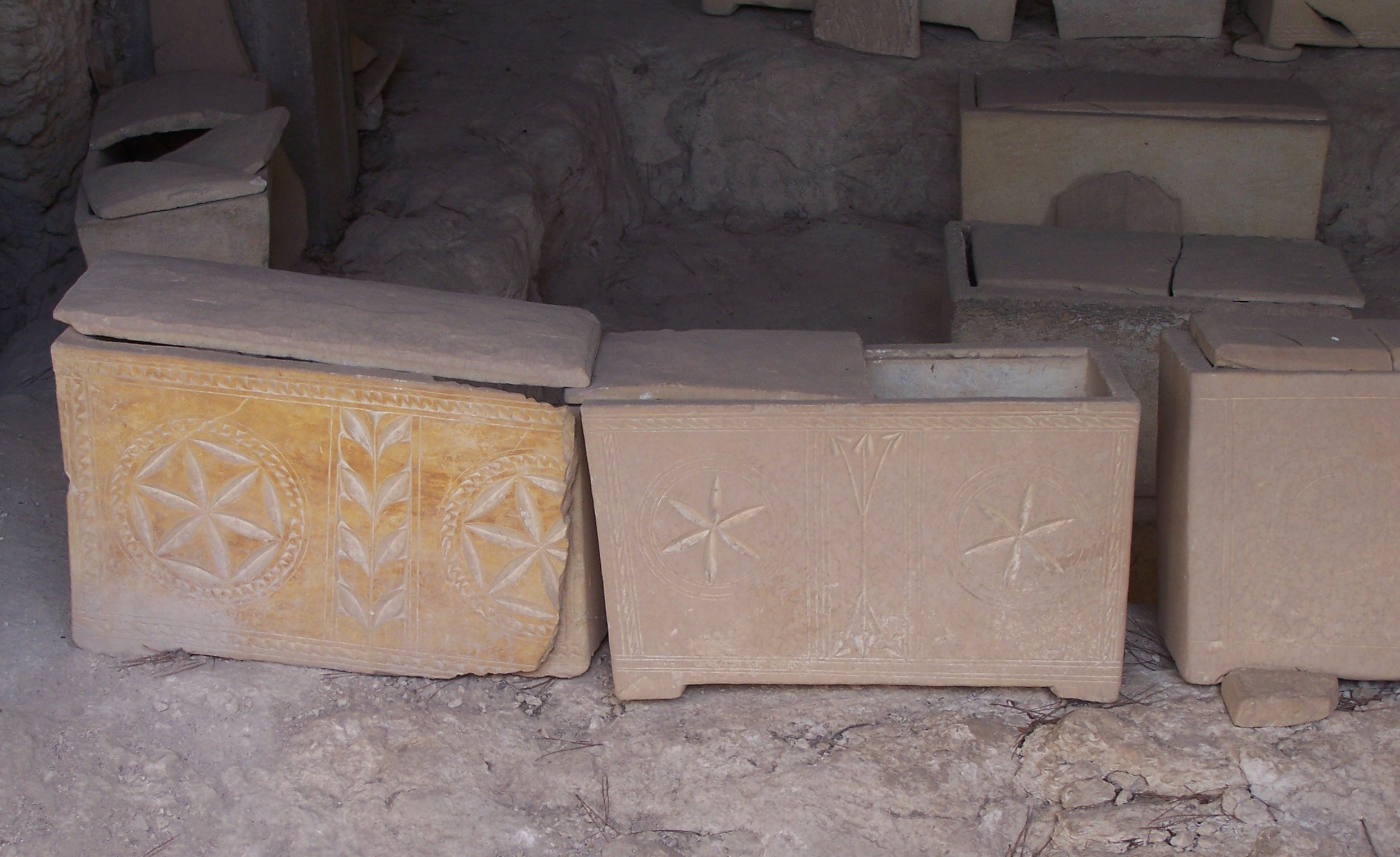
ossuary — (äsh′⋅ǝ⋅wer⋅ē) a “bone box,” a depository for the bones of the dead. According to Jewish burial practices in the land of Israel at the time of Jesus, the bones of the deceased were collected one year after an initial interment and reinterred in a small container usually carved from stone. Ossuaries were generally decorated with geometric or other designs, and often inscribed with the name(s) of the deceased. Sometimes the bones of several members of the same family were collected and placed in the same ossuary. The average size of these boxes was 50 cm. long, 30 cm. wide and 30 cm. high. About nine hundred ossuaries have been found in the vicinity of Jerusalem alone.
P
parenesis — (παραίνεσις, par⋅AI⋅ne⋅sis, “exhortation”) a style of discourse that exhorts an audience to act (or to refrain from acting) in a particular manner, typically moral or ethical in nature.
parenetic — pertaining to parenesis.
parousia — (παρουσία, parousia, “presence,” “coming,” “advent”) the term early Christians used for Jesus’ eschatological return. The term occurs in the Pauline epistles, James, 2 Peter and 1 John. In the Synoptic Gospels the term parousia is confined to Matthew.
patrilineal — tracing descent through the paternal line.
patristic — pertaining to the fathers of the early Church and their writings.
pericope — (pǝ⋅rik′⋅ǝ⋅pē, plural: pericopae) an episode or story unit in the Synoptic Gospels; a division of a synopsis.
pesher — (פֵּשֶׁר, PĒ⋅sher, “interpretation”; plural: pesharim) a style of commentary on Scripture attested in the Dead Sea Scrolls, according to which the scriptural text is interpreted as referring to recent events. Among the pesharim discovered at Qumran are the pesher to Habakkuk (1QpHab), the pesher to Isaiah (4QpIsaa-e [4Q161-165]), the pesher to Hosea (4QpHosa-b [4Q166-167]), the pesher to Nahum (4QpNah [4Q169]), and the pesher to the Psalms (4QpPsa,b [4Q171, 4Q173]).
piyyut — (פִּיּוּט, pi⋅YŪṬ; plural: פִּיּוּטִים, pi⋅yūṭ⋅IM) Hebrew liturgical poetry from the medieval period.
Pseudepigrapha — (sūd⋅i⋅pig′⋅rǝ⋅fǝ, literally, “falsely written”) a title scholars have given to various Jewish writings of the third century B.C.E. to the second century C.E. not found in the Hebrew Bible or Apocrypha, but known to scholars prior to the discovery of the Dead Sea Scrolls. The diverse collection of writings scholars refer to as Peseudepigrapha (such as James H. Charlesworth’s, The Old Testament Pseudepigrapha [2 vols.; Doubleday, 1983-1985], which includes fifty-two documents) did not exist as a collection in ancient times. Thus, Pseudepigrapha is an artificial (and somewhat arbitrary) category created by scholars. Fragments of some pesudepigraphical works, such as Enoch and Jubilees, have been found in Hebrew or Aramaic at Qumran. Many of the works included in collections of Pseudepigrapha falsely purport to have been written by famous scriptural figures (e.g., Enoch).
pseudepigraphical — pertaining to the Pseudepigrapha or having the characteristics of a pseudepigraphon.
pseudepigraphon — an individual work of the Pseudepigrapha or any ancient source written under a false name.
Q
Q — a conjectured Greek work believed by some scholars to be the source of Matthew and Luke’s non-Markan sayings. The designation “Q” is usually thought to be an abbreviation of the German Quelle, meaning “source”; however, the designation may have been chosen because Markan material was once thought to be from Peter, or P, and thus some second source would be Q.
qere — (קְרֵי, qe⋅RĒ) There are places within the Masoretic Text where the written tradition diverges from the vocalized tradition. When such divergences occur, the vocalized tradition at variance with the written text is referred to as “qere.”
R
R. — the English transliteration of ′ר, an abbreviation used in rabbinic literature for the honorific titles, רַבִּי (ra⋅BI, “Rabbi”), רַבָּן (ra⋅BĀN, “Rabban”), רַב (rav, “Rav”) and רַבֵּנוּ (ra⋅BĒ⋅nū, “Rabbenu”).
Rashi — acronym for Rabbi Shlomo ben Yitzhak; Rashi’s eleventh-century commentary on the Bible.
redact — the act of reworking the wording or structure of a source on the part of a copyist, editor or author.
redaction — the process or result of redacting a text. Redaction may be as innocuous as a minor stylistic improvement that results in little or no change to the meaning conveyed by the original source. On the other hand, redaction may introduce details or concepts alien to the original source (or conversely, details or concepts that were integral to the original source may be omitted). Such editorial activity could affect the meaning of the redacted source to a greater or lesser extent. All solutions to the Synoptic Problem that allow for any kind of literary dependence between the Gospels of Matthew, Mark and Luke presume some level of redactional activity on the part of the synoptic evangelists.
redaction criticism — the art/science of determining which details in a text are taken over from a source and which are due to the work or a redactor.
redactor — a person who reworks the wording or structure of a source.
responsa — (Latin plural of responsum; answer, reply, opinion) the usual English designation for the rabbinic expression שְׁאֵלוֹת וּתְשׁוּבוֹת (she⋅’ē⋅LŌT ū⋅te⋅shū⋅VŌT, “questions and answers”), the term responsa refers to the halakhic correspondence of rabbinic authorities, especially the written rulings of Geonim in response to halakhic queries written by Jews living outside Babylonia.
Restoration of Zion — the return to Jerusalem of the Jewish exiles in Babylonia during the days of Zerubbabel, Ezra and Nehemiah (6th-5th centuries B.C.E.), accompanied by the rebuilding of the Temple. The term שִׁיבַת צִיּוֹן (shi⋅VAT tzi⋅YŌN (“the return,” or “restoration,” “of Zion”) is taken from Psalm 126:1.
S
scale disease — a skin lesion that imparts severe ritual impurity, second only to that generated by a human cadaver. Often misleadingly translated as “leprosy,” which today refers to Hansen’s disease and is the result of a bacterial infection, scale disease may be the result of a variety of ailments, not necessarily including or limited to leprosy.
Second Commonwealth — a synonym for “Second Temple period.”
Second Temple period — literally, the period from the rebuilding of the Temple (536-516 B.C.E.) to its destruction by the Romans in 70 C.E. However, the term usually refers to the latter part of this period, beginning with the Hasmonean Uprising in 168 B.C.E., and often extending to the end of the Bar-Kochva Revolt in 135 C.E.
Seder Eliyahu — also known as Tanna d’ve Eliyahu, this work is composed of Seder Eliyahu Rabbah and Seder Eliyahu Zuta.
Semitism — the apparent imitation of Semitic grammar in a non-Semitic language or the use of a non-Semitic word in a particularly Semitic manner. Semitic languages include (among others) Hebrew, Aramaic and Arabic. Scholars typically refer to “Semitisms” in the New Testament when they do not wish to commit to which language (Hebrew or Aramaic) may have been behind the Semitic usage.
Septuagint — the Greek translation of the Hebrew Scriptures completed in Egypt between approximately 250 and 100 B.C.E. The earliest extant manuscripts of the Septuagint date from the 4th century C.E. “LXX” is a common abbreviation for the Septuagint in scholarly literature.
Septuagintism — (or sometimes “Septuagintalism”) a turn of phrase or grammatical construction used in imitation of the Septuagint. Many of the Hebraisms in the Gospels are explained away as Septuagintisms.
Shavuot — (שָׁבוּעוֹת, shā⋅vū⋅‘ŌT, “weeks”) the annual festival of the firstfruits celebrated at the conclusion of the seven weeks of counting the omer (Leviticus 23:15-21; Deuteronomy 16:9-12); also known as Pentecost from the Greek pentekoste (fiftieth day).
Shechinah — (שְׁכִינָה, she⋅chi⋅NĀH, “dwelling”) the divine presence that traveled with Israel in the wilderness and that inhabited the Temple in Jerusalem.

Shema — (שְׁמַע, she⋅MA‘ “Hear!”) the first word of Deuteronomy 6:4, “Hear [Shema], O Israel! The LORD our God, the LORD is one.” In Judaism this verse is the supreme affirmation of God’s oneness and uniqueness. Since at least the second century C.E. the Shema has consisted of three passages: Deuteronomy 6:4-9; 11:13-21; and Numbers 15:37-41, plus the accompanying benedictions that were recited before and after the three passages.
Song of Songs Rabbah — a midrash on the book of Song of Songs.
sotah — (סוֹטָה, sō⋅ṬĀH, “a straying or errant woman”) a woman suspected of adultery by her husband and who underwent the trial of “bitter water” (Numbers 5:11-31). Capitalized, “Sotah” refers to one of the tractates of the Mishnah.
source criticism — the art/science of determining which source(s) the author of an ancient text was using.
“string of pearls” — a term LOY researchers have coined to refer to small collections of originally unrelated sayings of Jesus that lack a narrative that occur in the Synoptic Gospels, especially in the Gospel of Luke (Luke 8:16-18; 9:23-27; 16:16-18; 17:1-6).
synopsis — a book in which the first three Gospels of the New Testament are arranged in parallel columns.
synoptic — an adjective derived from συνόψεσθαι (sūn⋅OPS⋅es⋅thai), a Greek verb meaning, “to view together, or at the same time”; specifically, the adjective refers to the first three Gospels of the New Testament.
Synoptic Apocalypse — a Triple Tradition discourse (Matt. 24; Mark 13; Luke 21) in which Jesus prophesies future events. The Synoptic Apocalypse is sometimes referred to as the Olivet Discourse since Mark and Matthew locate the discourse on the Mount of Olives.
Synoptic Gospels — Matthew, Mark and Luke. The Synoptic Gospels are so similar in form and content that it is convenient to view them together. The three are often printed in parallel columns; such a book is called a synopsis. With the aid of a synopsis, the Synoptic Gospels can be studied synoptically, that is, studied by comparing the similarities and differences between them. The Gospel of John is so unlike the Synoptic Gospels that there is limited value in trying to view it “synoptically” with the other three Gospels.
Synoptic Problem — the scholarly debate concerning the order in which the Synoptic Gospels were written and the literary sources used by each.
T
Talmud — (תַּלְמוּד, tal⋅MŪD, “instruction,” from lamad, “to study”) a collection of Jewish halakhah and aggadah comprising the Mishnah and the Gemara. The Gemara, commentary on the Mishnah, is printed section by section following each verse of the Mishnah. “Gemara” can be used in its narrow sense, the commentary on the Mishnah found in the Talmud, or in its wider sense as a synonym for “Talmud.” There are two Talmuds: the Jerusalem (or Palestinian) Talmud was completed about the end of the fourth century C.E.; the Babylonian Talmud, which became authoritative, was completed about a century later.
tannaic — (tǝ⋅nä′⋅ik) pertaining to the tannaim. (Sometimes also written “tannaitic.”)
tannaim — (תַּנָּאִים, ta⋅nā⋅’IM; singular: תַּנָּא, ta⋅NĀ’, tanna) sages from Hillel’s time (died ca. 10 B.C.E.) until the generation after Rabbi Yehudah ha-Nasi (ca. 230 C.E.), the compiler of the Mishnah.
targum — (תַּרְגּוּם, tar⋅GŪM; plural: targumim or targums) an Aramaic translation of a portion of the Hebrew Scriptures. The targumim not only provided a translation for those who did not understand the original language, but also provided an interpretation of the scriptural text. Since the inspired text could not be changed or altered in even the smallest way, the targum made possible the insertion of various explanations and clarifications that amplified the text. The targum dramatizes and adds additional information. According to the Targum of Ruth 1:1-2, for instance, “there was a mighty famine in the land, and a certain great man of Bethlehem in Judah went to live in the country of Moab; his two sons were chief Ephrathites who, when they came to Moab, were governors there” (italics highlight the differences in the Aramaic text of the targum compared to the Hebrew original).
tefillin — (תְּפִלִּין, te⋅fi⋅LIN) phylacteries. Leather capsules containing small parchment rolls on which certain scriptural verses are written. The capsules are strapped to the forehead and arms in accordance with scriptural commands.
tell — (תֵּל, tēl) a mound created by the debris of successive levels of human occupation.
Tetragrammaton — (τετραγράμματον, tet⋅ra⋅GRAM⋅ma⋅ton) the four-letter, unutterable, divine name of God (often transliterated in English as “YHWH”).
tetrarch — (τετράρχης, tet⋅RAR⋅chēs) originally, the ruler of the fourth part of a Roman province. By the first century C.E., the original sense had been lost, and “tetrarch” now meant a petty dependent ruler whose rank and authority were lower than that of an ethnarch.
tetrarchy — (τετραρχία, tet⋅rar⋅CHI⋅a) the office, jurisdiction, or territory of a tetrarch.
tevul yom — (טְבוּל יוֹם, ṭe⋅VŪL yōm, “immersed on that day”) a person who has incurred one of the uncleannesses for which Scripture ordains “he shall be unclean until evening,” has immersed him or herself in a mikveh, and now awaits the day’s end to be ritually pure (see Mishnah Kelim 1:8).
textual criticism — the art/science of evaluating textual variants in order to establish the original text of an ancient source, such as the New Testament.
textual variants — conflicting readings between different manuscripts of an ancient text, such as the New Testament. For instance, in some manuscripts we find the reading “a son or an ox” in Luke 14:5. Other manuscripts read “a donkey or an ox.”
Therapeutae — (θεραπευταί, the⋅ra⋅pev⋅TAI, “healers”) a semi-monastic Jewish sect in Alexandria, Egypt (first century C.E.). The Therapeutae were ascetics, but not celibates—they had wives and children. According to Shmuel Safrai, they appear to have been older men who, although not wealthy, had the means to devote their time to Scripture study, prayer and contemplation. In ancient sources they are mentioned only in Philo’s De vita contemplativa.
Tosefta — (תּוֹסֶפְתָּא, tō⋅sef⋅TĀ’, “the addition”) a collection of Oral Torah supplementing the Mishnah; compiled about 220-230 C.E., a generation after the Mishnah.
translation Greek — Greek that has been translated quite literally from Hebrew or Aramaic. The resulting Greek is slightly unnatural since it retains features of the source language.
translation variants — alternate translations of a word or phrase. Minor verbal discrepancies between the Synoptic Gospels have sometimes been explained as translation variants, but the overall verbal agreement between the Gospels makes this explanation unlikely. Independent translations would yield widely divergent wording, so the minor verbal discrepancies between the Gospels are probably due to redaction.
Triple Tradition (TT) — pericopae (story units) shared by all three Synoptic Gospels (e.g., the Baptism of Jesus or the Calming of the Storm).
Two-source Hypothesis — the dominant solution to the Synoptic Problem among scholars today. The Two-source Hypothesis proposes that Mark is the source of the Triple Tradition in Matthew and Luke, and that a separate sayings source, usually referred to as Q, is the source of the Double Tradition. The Two-source Hypothesis maintains that Matthew and Luke used both of their shared sources independently.
tzitzit — (צִיצִת, tzi⋅TZIT; plural: צִיצִיּוֹת, tzi⋅tzi⋅YŌT) the tassels God commanded the children of Israel to wear on the four corners of their garments (Num. 15:38-39).
U
unique Lukan material — pericopae (story units) found only in Luke’s Gospel.
unique Matthean material — pericopae (story units) found only in Matthew’s Gospel.
V
verbal identity — use of the same words, sometimes implying the same forms or sequence of words.
verbal relic — use of a linguistic feature (e.g., word, grammatical structure) carried over from an earlier source that no longer serves a specific function in its new context.
vorlage — (fȯr′⋅lä⋅gə; German: “that which lies before,” i.e., model, template) a term used by scholars to refer to a source document used by a translator, editor, or copyist. Often a text’s vorlage is a source that is no longer extant, but it can be reconstructed to some degree from clues in the text. For example, at many points the translators of the LXX used a vorlage different from the MT.
Z
Zealots — a fanatical sect of Jewish extremists during the Great Revolt (66-73 C.E.) who urged a war to the death against the Roman occupiers of the Land, and ruthlessly persecuted Jews who held more moderate views.


